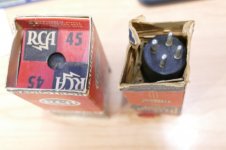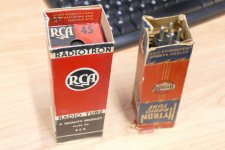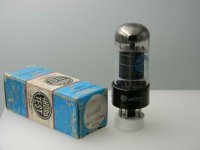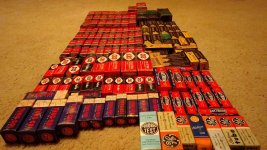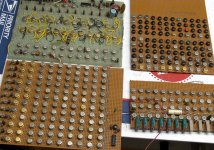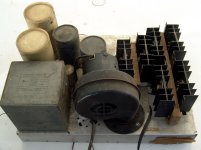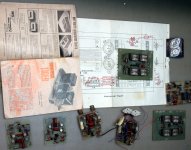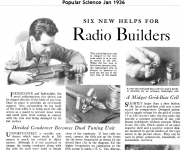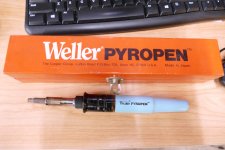> replacing the innards
"I have heard" that the Mallorys often fail by just drying out. That you micro-drill and use a hypodermic needle to inject a part-drop of water; an hour later it is alive.
Ultimately all the active-stuff must eat itself up, but not in 80 years? (Or maybe not after 30 years when the battery dries-out and electrolytic reactions slow to a stall; then maybe another 30 years once wet?)
"I have heard" that the Mallorys often fail by just drying out. That you micro-drill and use a hypodermic needle to inject a part-drop of water; an hour later it is alive.
Ultimately all the active-stuff must eat itself up, but not in 80 years? (Or maybe not after 30 years when the battery dries-out and electrolytic reactions slow to a stall; then maybe another 30 years once wet?)
NEVER seen that in the US. Tube boxes were highly standardized. I don't even remember them having a seal. But I do remember you could not get a new tube from the drawer yourself, you asked the clerk to unlock it and pluck a tube. (But maybe this was only when they saw me coming?)
You have to go back to the days when an open filament was the most common tube failure. The "seal" in these boxes was the staple, hence the notice on the 45 box. By the time of the drug store tube tester, all the boxes were indeed standardized, and not sealed.
In every case that I ever met the drawers were kept locked. In the Olson store the drawers were empty and all the tubes were on the shelf behind the counter next to the batteries.
Testing the new tube VS the "bad" tube was always advised. I never heard of a "secret switch" but some tube testers were somewhat "uncalibrated." We had an "Eagle Army Navy" store nearby with a tester that found lots of "bad" or "weak" tubes. I went there often since they sold "Thoro-Test" tubes. Every tube was $1 regardless of what the number was. Not a deal for a 50 cent 12AU6, but I kept them cleaned out of 6L6GCs which were about $3 at the Lafayette Radio Electronics store.
Thoro Test tubes were rejected GE's. I never got a bad one, but most of the new ones tested weak on the Eagle tester, but good at Allen's Drugs. They new that the dumm blonde kid knew what they were doing.
Attachments
Thoro test 6K6
looks like some were from Japan
looks like some were from Japan
Attachments
Last edited:
Ultimately all the active-stuff must eat itself up, but not in 80 years? (Or maybe not after 30 years when the battery dries-out and electrolytic reactions slow to a stall; then maybe another 30 years once wet?)
Sounds almost like a iron-nickel battery. "Watering your batteries every 1-3 months is the biggest maintenance requirement"
...
Thoro Test tubes were rejected GE's. I never got a bad one, but most of the new ones tested weak on the Eagle tester, but good at Allen's Drugs. They new that the dumm blonde kid knew what they were doing.
This is fun - I remember the tube tester at the local Thrifty drug store. I was not as focused on tubes as George was, but I did scrounge for electronic bits at the local TV repair shop. More interesting was the beer that I found in the dumpster at the market a few doors down!
I was not as focused on tubes as George was, but I did scrounge for electronic bits at the local TV repair shop.
As a kid in the late 50's and early 60's with limited knowledge I played with tubes because they, and the other parts needed to make them play were essentially free. Discarded TV's, radios, and HiFi sets were everywhere. Since I really didn't know what I was doing early on, free parts were a good thing because I blew stuff up a lot.
Shopping in the trash bins behind the TV shop was easy, but the real fun began when I met a friend who had an older brother with a car. They taught me the fine art of dumpster diving at electronics manufacturing places, and importer's warehouses. By the 10th grade we could load up a car trunk full of damaged low buck radios and cheap stereo sets at the Julliette importer, then go next door to Pearce Simpson for some CB sets, then hit Coulter Diagnostics and Racal Milgo factories for scrap circuit boards full of semiconductor goodies.
Here are some of the boards I built in 1971 as part of a large digital music synthesizer. All of the round TO-5 sized cans are RTL IC chips. Each can contains a single gate or flip flop. It takes a lot of parts to do simple digital tasks like generate every musical note on a 49 key keyboard salvaged from a scrap organ. By 12th grade (1969) I had created a solid state "booster amp" that made about 300 watts into a 4 ohm load at an unknown level of THD, as we had no way to measure it. When driven by a 5 watt Fender Champ clone it was the "loudest guitar amp in Miami."
After high school I ran the service department of an Olson Electronics store for two years, then got a "real" job at Motorola where I stayed for 41 years. Silicon was free just by filling out a sample request form, so by the early 70's we were cranking out clones of nearly everything in the SWTPC catalog, including the MC6800 computer in 1975.
All of my DIY was exclusively solid state until I traded my first car, a 1949 Plymouth for a dead Scott 272 stereo in the early 90's. After fixing it, the Carver and Phase Linear stuff was kicked right out of the stereo rack, never to see power again until I gave it all away. With a few exceptions all audio DIY has been tube powered ever since.
It was pretty easy to take two or three CB sets, radios, or 8-track players and make one or two good ones, which we sold at school to fund our electronics habit. By this time tubes were only being used for LOUD guitar amps. All other DIY projects had become solid state, even small guitar amps.
Attachments
Funny how times have changed so much from
"Come test your tubes and fix your own radio or TV"
To
"DONT OPEN THAT! You will void the warranty"
Or even just "Not worth fixing, just buy a new one"
I remember as a kid the "TV Repair man" coming to look at Grandads old TV which was already out of date in the 70's. He had a suitcase full of new tubes in their boxes and capacitors n resistors.
The repair guy was always happy to talk to me and tell me what he was doing and why something failed and how that old TV/Radio Gram worked. It was a full piece of furniture as wide as the piano.
When it finally died (caught fire from a lightning strike) I remember the TV man took it away for them and S&W Miller delivered a Rank Arena colour set with wooden case and legs that I later used as my own TV in my 30's.
It had one of those ultra sonic remotes you could hear working.
Well I used to be able to hear working till my mid 40's when the industrial deafness and constant ringing set in.
"Come test your tubes and fix your own radio or TV"
To
"DONT OPEN THAT! You will void the warranty"
Or even just "Not worth fixing, just buy a new one"
I remember as a kid the "TV Repair man" coming to look at Grandads old TV which was already out of date in the 70's. He had a suitcase full of new tubes in their boxes and capacitors n resistors.
The repair guy was always happy to talk to me and tell me what he was doing and why something failed and how that old TV/Radio Gram worked. It was a full piece of furniture as wide as the piano.
When it finally died (caught fire from a lightning strike) I remember the TV man took it away for them and S&W Miller delivered a Rank Arena colour set with wooden case and legs that I later used as my own TV in my 30's.
It had one of those ultra sonic remotes you could hear working.
Well I used to be able to hear working till my mid 40's when the industrial deafness and constant ringing set in.
.......In some radios, the detector/first audio tube had a small wired-in battery, 1 or 2 volts, that kept the cathode above ground.... likely around 1930's era.
Attachments
My first soldering iron was given to me by my grandfather. It looked a lot like the one in that picture. Now you know why all of my early projects used octal tubes and those fragile brown wafer sockets.
My first soldering iron was actually the iron from a woodburner kit. I finished all the plaques. I got bored and figured out it would melt solder. I went headfirst into the rabbit hole from there.
We still have a few irons like that at work... cloth covered mains cord and everything. They're mostly squirreled away in cockroach-infested storage rooms, out of the safety man's sight...
I definitely don't miss the big old wood-burner style irons. Actually, I really don't miss my old Weller either. I had to use one the other day, and I really didn't remember how bad it was. It's like getting used to fountain pens, and using them exclusively for several years, then trying to fill out a form with a ball-point.
I definitely don't miss the big old wood-burner style irons. Actually, I really don't miss my old Weller either. I had to use one the other day, and I really didn't remember how bad it was. It's like getting used to fountain pens, and using them exclusively for several years, then trying to fill out a form with a ball-point.
And you probably know EXACTLY where in those cockroach infested store rooms they are, for when they are the only thing on the planet that will do the job. Safety man would like it even less if you lit up a propane cylinder in the lab because that stupid little SMD iron couldn’t generate enough heat.
In my shop's tool chest is where I keep my big old trusty 100W soldering iron.
Cloth covered cord, original clunky plug on it.
It's the only thing that quickly solders/UNsolders parts and shields that have been fastened to those old steel chassis of vintage radios, etc.
Cloth covered cord, original clunky plug on it.
It's the only thing that quickly solders/UNsolders parts and shields that have been fastened to those old steel chassis of vintage radios, etc.
And you probably know EXACTLY where in those cockroach infested store rooms they are, for when they are the only thing on the planet that will do the job. Safety man would like it even less if you lit up a propane cylinder in the lab because that stupid little SMD iron couldn’t generate enough heat.
I know I still have my Weller soldering gun that I bought new in 1965, since I would never toss it. What I don't know is which box it's in since I moved house twice.
In case you need some serious heat, but a full size propane torch is out of the question, there are small sized "fire sticks." This has direct flame mode for some extra crispy component extraction outdoors, or catalytic converter mode where the air is shut off and only real hot CO2 is emitted. Turned down to minimum heat it is useful for SMD reflow. On full power it blows parts off the board. Mine is over 30 years old, so I don't know if you can still get them.
Attachments
I have one of these for auto electric.
https://www.amazon.ca/Weller-PSI100...0ICGN38/ref=pd_lpo_1?pd_rd_i=B000ICGN38&psc=1

https://www.amazon.ca/Weller-PSI100...0ICGN38/ref=pd_lpo_1?pd_rd_i=B000ICGN38&psc=1

- Home
- Amplifiers
- Tubes / Valves
- Who remembers...
